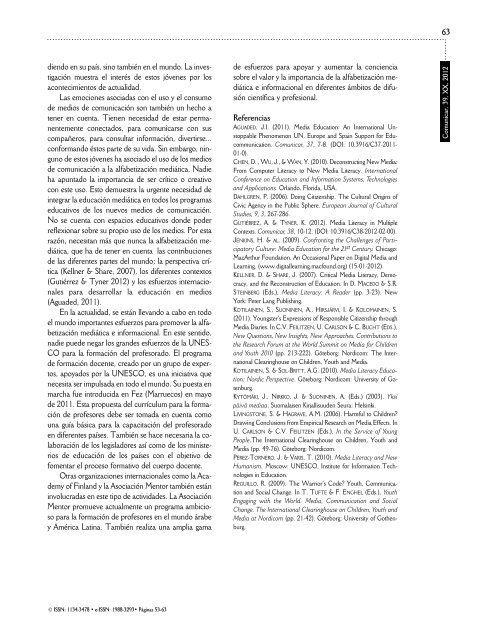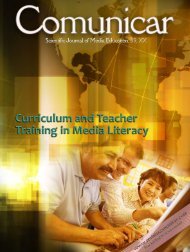Comunicar 39 - Revista Comunicar
Comunicar 39 - Revista Comunicar
Comunicar 39 - Revista Comunicar
Create successful ePaper yourself
Turn your PDF publications into a flip-book with our unique Google optimized e-Paper software.
63<br />
diendo en su país, sino también en el mundo. La investigación<br />
muestra el interés de estos jóvenes por los<br />
acontecimientos de actualidad.<br />
Las emociones asociadas con el uso y el consumo<br />
de medios de comunicación son también un hecho a<br />
tener en cuenta. Tienen necesidad de estar per ma -<br />
nen temente conectados, para co municarse con sus<br />
compañeros, para consultar información, divertirse...<br />
conformando éstos parte de su vida. Sin embargo, ninguno<br />
de estos jóvenes ha asociado el uso de los medios<br />
de comunicación a la alfabetización mediática. Nadie<br />
ha apuntado la importancia de ser crítico o creativo<br />
con este uso. Esto demuestra la urgente necesidad de<br />
integrar la educación mediática en todos los programas<br />
educativos de los nuevos medios de comunicación.<br />
No se cuenta con espacios educativos donde poder<br />
reflexionar sobre su propio uso de los medios. Por esta<br />
razón, necesitan más que nunca la alfabetización me -<br />
diática, que ha de tener en cuenta las contribuciones<br />
de las diferentes partes del mundo; la perspectiva crítica<br />
(Kellner & Share, 2007), los diferentes contextos<br />
(Gutiérrez & Tyner 2012) y los es fuerzos internacionales<br />
para desarrollar la educación en medios<br />
(Aguaded, 2011).<br />
En la actualidad, se están llevando a cabo en todo<br />
el mundo importantes esfuerzos para promover la alfabetización<br />
mediática e informacional. En este sentido,<br />
nadie puede negar los grandes esfuerzos de la UNES-<br />
CO para la formación del profesorado. El programa<br />
de formación docente, creado por un grupo de expertos,<br />
apoyados por la UNESCO, es una iniciativa que<br />
necesita ser impulsada en todo el mundo. Su puesta en<br />
marcha fue introducida en Fez (Marruecos) en mayo<br />
de 2011. Esta propuesta del currículum para la formación<br />
de profesores debe ser tomada en cuenta como<br />
una guía básica para la capacitación del profesorado<br />
en diferentes países. También se hace necesaria la co -<br />
laboración de los legisladores así como de los ministerios<br />
de educación de los países con el objetivo de<br />
fomentar el proceso formativo del cuerpo docente.<br />
Otras organizaciones internacionales como la Aca -<br />
demy of Finland y la Asociación Mentor también están<br />
involucradas en este tipo de actividades. La Aso ciación<br />
Mentor promueve actualmente un programa ambicioso<br />
para la formación de profesores en el mun do árabe<br />
y América Latina. También realiza una am plia gama<br />
de esfuerzos para apoyar y aumentar la conciencia<br />
sobre el valor y la importancia de la alfabetización me -<br />
diática e informacional en diferentes ámbitos de difusión<br />
científica y profesional.<br />
Referencias<br />
AGUADED, J.I. (2011). Media Education: An International Un -<br />
stoppable Phenomenon UN, Europe and Spain Support for Educommunication.<br />
<strong>Comunicar</strong>, 37, 7-8. (DOI: 10.<strong>39</strong>16/C37-2011-<br />
01-0).<br />
CHEN, D. , WU, J., & WAN, Y. (2010). Deconstructing New Media:<br />
From Com puter Literacy to New Media Literacy. Inter national<br />
Con ference on Education and Information Systems, Tech nologies<br />
and Applications. Orlando, Florida, USA.<br />
DAHLGREN, P. (2006). Doing Citizenship. The Cultural Origins of<br />
Ci vic Agency in the Public Sphere. European Journal of Cultural<br />
Studies, 9, 3, 267-286.<br />
GUTIÉRREZ, A. & TYNER, K. (2012). Media Literacy in Multiple<br />
Contexts. <strong>Comunicar</strong>, 38, 10-12. (DOI: 10.<strong>39</strong>16/C38-2012-02-00).<br />
JENKINS, H. & AL. (2009). Confronting the Challenges of Par ti -<br />
cipatory Culture: Media Education for the 21 st Century. Chicago:<br />
MacArthur Foundation. An Occasional Paper on Digital Media and<br />
Learning. (www.digitallearning.macfound.org) (15-01-2012).<br />
KELLNER, D. & SHARE, J. (2007). Critical Media Literacy, Demo -<br />
cracy, and the Reconstruction of Education. In D. MACEDO & S.R.<br />
STEINBERG (Eds.), Media Literacy: A Reader (pp. 3-23). New<br />
York: Peter Lang Publishing.<br />
KOTILAINEN, S., SUONINEN, A., HIRSJÄRVI, I. & KOLOMAINEN, S.<br />
(2011). Youngster’s Expressions of Responsible Citizenship through<br />
Media Diaries. In C.V. FEILITZEN, U. CARLSON & C. BUCHT (EDS.),<br />
New Questions, New Insights, New Approaches. Contributions to<br />
the Research Forum at the World Summit on Media for Children<br />
and Youth 2010 (pp. 213-222). Göteborg: Nordicom: The Inter -<br />
national Clearinghouse on Children, Youth and Media.<br />
KOTILAINEN, S. & SOL-BRITT, A.G. (2010). Media Literacy Edu ca -<br />
tion: Nordic Perspective. Göteborg: Nordicom: University of Go -<br />
tenburg.<br />
KYTÖMÄKI, J., NIRKKO, J. & SUONINEN, A. (Eds.) (2003). Yksi<br />
päivä mediaa. Suomalaisen Kirjallisuuden Seura: Helsinki.<br />
LIVINGSTONE, S. & HAGRAVE, A.M. (2006). Harmful to Children?<br />
Drawing Conclusions from Empirical Research on Media Effects. In<br />
U. CARLSON & C.V. FEILITZEN (Eds.), In the Service of Young<br />
People.The International Clearinghouse on Children, Youth and<br />
Media (pp. 49-76). Göteborg: Nordicom.<br />
PÉREZ-TORNERO, J. & VARIS, T. (2010). Media Literacy and New<br />
Humanism. Moscow: UNESCO, Institute for Information Tech -<br />
no logies in Education.<br />
REGUILLO, R. (2009). The Warrior’s Code? Youth, Communica -<br />
tion and Social Change. In T. TUFTE & F. ENGHEL (Eds.), Youth<br />
Engaging with the World. Media, Communication and Social<br />
Change. The International Clearinghouse on Children, Youth and<br />
Media at Nordicom (pp. 21-42). Göteborg: University of Gothen -<br />
burg.<br />
<strong>Comunicar</strong>, <strong>39</strong>, XX, 2012<br />
© ISSN: 1134-3478 • e-ISSN: 1988-3293• Páginas 53-63

















